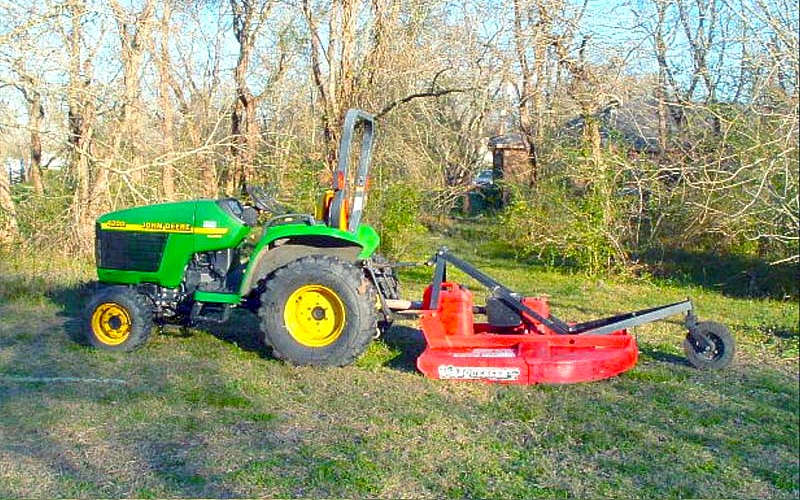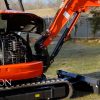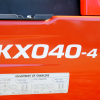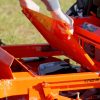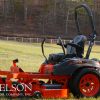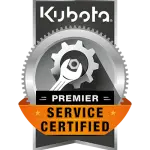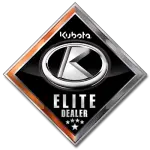The hydraulic systems on modern compact tractors make them incredibly versatile. Hundreds of attachments available for every brand and model can perform more jobs on your property than you can imagine.
When you’re deciding what implements to buy for your compact tractor, start by making a list of the most common and immediate tasks you need done, plus tasks sure to come up in the future. Prioritize your list by importance to decide what to purchase now, and what you can put off for later.
Since each implement serves different purposes, your list of tasks will probably be a lot longer than the list of attachments needed to accomplish them.
There are seemingly as many implement manufacturers as there are stars in the the sky so be careful what you buy! Make sure you buy from a reputable dealer that offers parts, service, and will perform warranty work should you have a break down. Most Tractor manufacturers make their own implements or they may have a recommended brand that they have a marketing agreement with. This is the safest way to go because if something does go wrong you have that relationship between the tractor manufacturer and the implement manufacturer to back you up! If you buy a third-party attachment, make sure the fittings are correct for your three-point hitch and PTO driveline design, and make sure the implement is not too heavy for your model. Plus make absolutely sure they offer replacement parts and are authorized to perform warranty work.
Here are the most popular implements on the market for the most common jobs.
Front Loaders
The good news is that most new tractors from our most popular major brands like John Deere, Kubota, and New Holland come factory-equipped with one of your favorite tools, a front loader and a standard bucket. To ensure the tool will be up for the task, verify the loader’s breakout force, weight capacity, and lift height. To make your job easier, you want a quick-attach system for easy switching between front attachments and a curved boom for maximum field of vision.
Mowers
Mowing can be a complicated issue on a large property. You may have to contend with yard, pasture, uncleared land, sloped areas, and unseen obstacles hidden in tall weeds. Don’t worry. With the right mowing deck, your tractor can handle every job.
Finish mowers are used for lawn work on cleared land. Typically the mowers have adjustable height ranges of 3/4 to 5 ½ inches and 60 to 70 inches of cutting width and are available mid or rear mounted models. For better visibility a mid mounted mowing deck is best, but for ease of connection, a rear mounted mower is easiest. Finish mowers are made to “float” to follow the ground’s natural contours and still produce a uniform cut. They are used on sports fields, golf courses, larger properties and some yards to create beautiful swaths of green.
Rotary cutters, also called bush or brush hogs, are made to handle wilder terrain. Since they are made to chop down thicker, higher growth, rotary cutters come equipped with a “stump jumper” feature and shear bolt or slip clutch to protect the mechanical parts from damage. OSHA compliant shielding protects the operator from anything that might be thrown up.
Backhoes
If you have property, eventually you’re going to need to dig. Whether you’re digging a trench for pipes, installing a new septic tank, or leveling land for new construction, tractor backhoe attachments are the perfect tool. They can gouge out up to 8 feet of hole, and the compact arrangement works well even in a small area.
If you’re looking to purchase a new tractor with backhoe tasks as a priority, look for a model with an integral mainframe to absorb the force and weight of twisting loads, a braceless loader frame to improve operator visibility, and backhoe crawling mode. This feature lets you move back and forth along a trench as you work.
Blades
Blades come in different styles and perform a variety of tasks, including grading, snow clearing, gravel or feed spreading. Options include front or rear mounted blades and box blades.
Front mounted blades come 60 or 70 inches wide and while they are designed for snow removal, they can push piles of anything: sand, gravel, feed, mulch, or any pile of lightweight material in need of spreading.
Rear mounted blades are generally used for grading tasks like leveling a gravel drive.
Snowblowers
When snow piles up in deep drifts (not that we have that problem often here in sunny Georgia), a front or rear mounted snowblower is the answer. They come in widths of 51 to 64 inches and the chutes rotate to blow snow in different directions (changing direction might be manual or hydraulic, depending on the make and model).
That’s your top 5 most popular implements, but hardly the only tools available. Here are a few more to put on your wish list:
- Carts – I know, I was surprised carts weren’t at the top of the list, too. You can use a cart to move everything from wood to build a deer stand to large mineral licks for your livestock.
- Earth Augers – When you have property of any kind, digging is a necessity. Whether you’re installing in or repairing a fence, putting up barn, or planting trees, an auger or post hole digger will come in handy.
- Rotary tillers – when you’re ready to plant, tractors can’t be beat. Climb on that John Deere to clear a plot, then hook up a tiller to aerate and loosen the soil. If you’ve already spread your fertilizer, tilling will mix it into the soil to create a growing environment rich in nutrients.
- Fertilizer spreaders – who wants to do that job by hand? Your tractor will pull a cart designed to deposit fertilizer evenly, exactly where you need it.
- Hay balers – when you’re ready to cut and dry nutritious grains to help your cattle stay fed through the winter, hay baler attachments make it easy. They are designed to mow, rake, compact, and bale in one sweep.
Your tractor is likely to be the most versatile piece of equipment you’ll ever own. Consider it an investment in your success, and choose a model that will deliver the power and versatility you need for years to come. Need advice? We’ll be glad to help you choose the right tractor.
